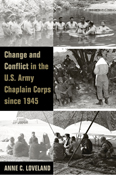Change and Conflict in the U.S. Army Chaplain Corps since 1945

Army chaplains have long played an integral part in America’s armed forces. In addition to conducting chapel activities on military installations and providing moral and spiritual support on the battlefield, they conduct memorial services for fallen soldiers, minister to survivors, offer counsel on everything from troubled marriages to military bureaucracy, and serve as families-points of contact for wounded or deceased soldiers-all while risking the dangers of combat alongside their troops. In this thoughtful study, Anne C. Loveland examines the role of the army chaplain since World War II, revealing how the corps has evolved in the wake of cultural and religious upheaval in American society and momentous changes in U.S. strategic relations, warfare, and weaponry.
From 1945 to the present, Loveland shows, army chaplains faced several crises that reshaped their roles over time. She chronicles the chaplains’ initiation of the Character Guidance program as a remedy for the soaring rate of venereal disease among soldiers in occupied Europe and Japan after World War II, as well as chaplains’ response to the challenge of increasing secularism and religious pluralism during the “culture wars” of the Vietnam Era. “Religious accommodation,” evangelism and proselytizing, public prayer, and “spiritual fitness” provoked heated controversy among chaplains as well as civilians in the ensuing decades. Then, early in the twenty-first century, chaplains themselves experienced two crisis situations: one the result of the Vietnam-era anti chaplain critique, the other a consequence of increasing religious pluralism, secularization, and sectarianism within the Chaplain Corps, as well as in the army and the civilian religious community.
By focusing on army chaplains’ evolving, sometimes conflict-ridden relations with military leaders and soldiers on the one hand and the civilian religious community on the other, Loveland reveals how religious trends over the past six decades have impacted the corps and, in turn, helped shape American military culture.
